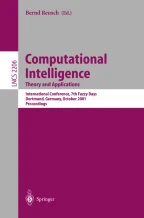Abstract
In this paper we highlight the specific meaning of images of fuzzy sets under fuzzy relations in the context of fuzzy topology. More precisely we show that fuzzy modifiers taking direct and superdirect images of fuzzy sets under fuzzy pre-orderings are respectively closure and interior operators, inducing fuzzy topologies. Furthermore we investigate under which conditions the same applies to the recently introduced general closure and opening operators based on arbitrary fuzzy relations.
Access this chapter
Tax calculation will be finalised at checkout
Purchases are for personal use only
Preview
Unable to display preview. Download preview PDF.
Similar content being viewed by others
References
Bandler, W., Kohout, L. J.: Fuzzy Relational Products as a Tool for Analysis and Synthesis of the Behaviour of Complex Natural and Artificial Systems. In: Wang, S. K., Chang, P.P. (eds.): Fuzzy Sets: Theory and Application to Policy Analysis and Information Systems. Plenum Press, New York and London (1980) 341–367.
Bodenhofer, U.: Generalized Opening and Closure Operators of Fuzzy Relations. Submitted to FLA’2001 (private communication) (2000)
Chang, C. L.: Fuzzy Topological Spaces. Journal of Mathematical Analysis and Applications 24 (1968) 182–190
De Cock, M., Kerre, E. E.: A New Class of Fuzzy Modifiers. In: Proceedings of ISMVL2000, IEEE Computer Society (2000) 121–126
De Cock, M., Nachtegael, M., Kerre, E. E.: Images under Fuzzy relations: A Master-Key to Fuzzy Applications. In: Ruan, D., Abderrahim, H. A., D’hondt, P., Kerre, E. E. (eds.): Intelligent Techniques and Soft Computing in Nuclear Science and Engineering, Proceedings of FLINS 2000. World Scientific (2000) 47–54
De Cock, M., Radzikowska, A., Kerre, E. E.: Modelling Linguistic Modifiers Using Fuzzy-Rough Structures. In: Proceedings of IPMU2000 (2000) 1735–1742
De Cock, M., Bodenhofer, U., Kerre, E. E.: Modelling Linguistic Expressions Using Fuzzy Relations. In: Proceedings 6th Int. Conf. on Soft Computing (IIZUKA2000), (CD-ROM) (2000) 353–360
Dubois, D., Prade, H.: Rough Fuzzy Sets and Fuzzy Rough Sets. Int. J. of General Systems, 17(2–3) (1990) 191–209
Dubois, D., Prade, H.: Putting fuzzy sets and rough sets together. In: Roman Słowiński (ed.): Intelligent Decision Support. Kluwer Academic (1992) 203–232
Nachtegael, M., Radzikowska, A., Kerre, E. E.: On Links between Fuzzy Morphology and Fuzzy Rough Sets. In: Proceedings of IPMU2000 (2000) 1381–1388
Kerre, E. E.: Fuzzy Topologizing with Preassigned Operations, International Congress of Mathematics, Helsinki (1978)
Kerre, E. E.: Introduction to the Basic Principles of Fuzzy Set Theory and Some of its Applications. Communication and Cognition, Gent (1993)
Kerre, E. E., De Cock, M.: Linguistic Modifiers: an overview. In: Chen, G., Ying, M., Cai, K.-Y. (eds.): Fuzzy Logic and Soft Computing. Kluwer Academic Publishers (1999) 69–85
Pawlak, Z.: Rough sets. Int. J. of Computer and Information Science, 11(5) (1982) 341–356
Radzikowska, A. M., Kerre, E. E.: A Comparative Study of Fuzzy Rough Sets. To appear in Fuzzy Sets and Systems.
Thiele, H.: Interpreting Linguistic Hedges by Concepts of Functional Analysis and Mathematical Logic. In: Proceedings of EUFIT’98, volume I (1998) 114–119
Ying-Ming, L., Mao-Kang, L.: Fuzzy Topology. Advances in Fuzzy Systems — Applications and Theory Vol. 9. World Scientific, Singapore, New Jersey, London, Hong Kong (1997)
Author information
Authors and Affiliations
Editor information
Editors and Affiliations
Rights and permissions
Copyright information
© 2001 Springer-Verlag Berlin Heidelberg
About this paper
Cite this paper
De Cock, M., Kerre, E.E. (2001). Fuzzy Topologies Induced by Fuzzy Relation Based Modifiers. In: Reusch, B. (eds) Computational Intelligence. Theory and Applications. Fuzzy Days 2001. Lecture Notes in Computer Science, vol 2206. Springer, Berlin, Heidelberg. https://doi.org/10.1007/3-540-45493-4_28
Download citation
DOI: https://doi.org/10.1007/3-540-45493-4_28
Published:
Publisher Name: Springer, Berlin, Heidelberg
Print ISBN: 978-3-540-42732-2
Online ISBN: 978-3-540-45493-9
eBook Packages: Springer Book Archive
